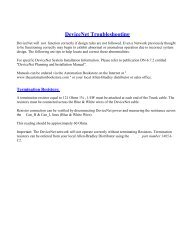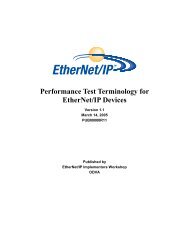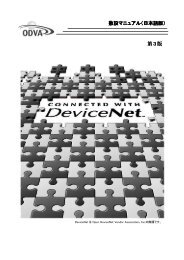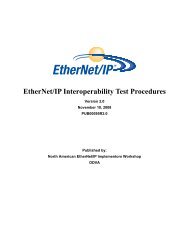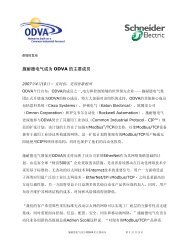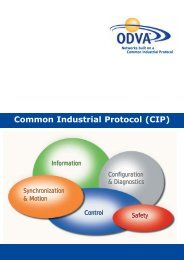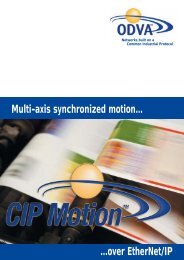IPv6 for EtherNet/IP: Is the Sky Falling, or Just an Acorn? - ODVA
IPv6 for EtherNet/IP: Is the Sky Falling, or Just an Acorn? - ODVA
IPv6 for EtherNet/IP: Is the Sky Falling, or Just an Acorn? - ODVA
Create successful ePaper yourself
Turn your PDF publications into a flip-book with our unique Google optimized e-Paper software.
<strong><strong>IP</strong>v6</strong> <strong>f<strong>or</strong></strong> <strong>E<strong>the</strong>rNet</strong>/<strong>IP</strong>: <strong>Is</strong> <strong>the</strong> <strong>Sky</strong> <strong>Falling</strong>, <strong>or</strong> <strong>Just</strong> <strong>an</strong> Ac<strong>or</strong>n?<br />
Bri<strong>an</strong> Batke<br />
Principal Engineer<br />
Rockwell Automation<br />
Paul Brooks<br />
Business Development M<strong>an</strong>ager<br />
Rockwell Automation<br />
Presented at <strong>the</strong> <strong>ODVA</strong><br />
2011 <strong>ODVA</strong> Industry Conference & 14 th Annual Meeting<br />
March 1-3, 2011<br />
Phoenix, Arizona, USA<br />
Abstract:<br />
Despite <strong>the</strong> predictions over <strong>the</strong> last 20 years, <strong><strong>IP</strong>v6</strong> still has not seen widespread adoption. Will this<br />
continue? We discuss <strong>the</strong> fact<strong>or</strong>s that will drive <strong><strong>IP</strong>v6</strong> adoption, <strong>the</strong> implications <strong>f<strong>or</strong></strong> <strong>E<strong>the</strong>rNet</strong>/<strong>IP</strong>, <strong>an</strong>d<br />
recommend a course of action <strong>f<strong>or</strong></strong> <strong>the</strong> <strong>E<strong>the</strong>rNet</strong>/<strong>IP</strong> vend<strong>or</strong> community.<br />
Body:<br />
Ano<strong>the</strong>r Y2K?<br />
As far back as <strong>the</strong> mid-1990s we heard warnings that we would “soon” run out of <strong>IP</strong> addresses.<br />
Consequently, we needed to prepare <strong>f<strong>or</strong></strong> <strong>the</strong> imminent coming of <strong>IP</strong>ng, also known as <strong><strong>IP</strong>v6</strong>. The fact that<br />
<strong>the</strong> “ng” in <strong>IP</strong>ng was inspired by <strong>the</strong> (<strong>the</strong>n current) Star Trek: The Next Generation should remind us how<br />
long we have been on <strong>the</strong> verge of running out of <strong>IP</strong>v4 addresses.<br />
Th<strong>an</strong>kfully, we learned something from <strong>an</strong>o<strong>the</strong>r predicted disaster that failed to materialize: Y2K.<br />
Thus far we have resisted expending <strong>the</strong> ef<strong>f<strong>or</strong></strong>t to <strong>f<strong>or</strong></strong>mally define <strong><strong>IP</strong>v6</strong> supp<strong>or</strong>t in <strong>E<strong>the</strong>rNet</strong>/<strong>IP</strong>, simply<br />
because <strong>the</strong>re has not been a compelling reason to do so. But unlike Y2K, which was a one-time event<br />
now largely <strong>f<strong>or</strong></strong>gotten, <strong><strong>IP</strong>v6</strong> will have a lasting presence. There seems to be no dispute that <strong><strong>IP</strong>v6</strong> will play<br />
<strong>an</strong> imp<strong>or</strong>t<strong>an</strong>t role in <strong>the</strong> Internet.<br />
The question <strong>f<strong>or</strong></strong> industrial automation users <strong>an</strong>d vend<strong>or</strong>s remains: what will be <strong>the</strong> impact of <strong><strong>IP</strong>v6</strong>, <strong>an</strong>d<br />
what should we be doing about it?<br />
Extending <strong>the</strong> Life of <strong>IP</strong>v4<br />
Engineers w<strong>or</strong>king on Internet protocols, being a pragmatic bunch, have devised solutions to extend <strong>the</strong><br />
life of <strong>IP</strong>v4. Primary among <strong>the</strong>se solutions are RFC 1918 <strong>an</strong>d Netw<strong>or</strong>k Address Tr<strong>an</strong>slation (NAT).<br />
RFC 1918 defines <strong>the</strong> now-familiar private <strong>IP</strong>v4 address r<strong>an</strong>ges:<br />
2011 <strong>ODVA</strong> Industry Conference 1 ©2011 <strong>ODVA</strong>, Inc.
10.0.0.0 - 10.255.255.255 (10/8 prefix)<br />
172.16.0.0 - 172.31.255.255 (172.16/12 prefix)<br />
192.168.0.0 - 192.168.255.255 (192.168/16 prefix)<br />
Within <strong>an</strong> enterprise <strong>or</strong> home netw<strong>or</strong>k, it is not necessary <strong>f<strong>or</strong></strong> each node to have a public <strong>IP</strong> address.<br />
Org<strong>an</strong>izations c<strong>an</strong> use private <strong>IP</strong> address r<strong>an</strong>ges <strong>the</strong>n use NAT to present a small number of public <strong>IP</strong><br />
addresses to <strong>the</strong> Internet.<br />
[Figure 1. Netw<strong>or</strong>k Address Tr<strong>an</strong>slation.]<br />
The widespread use of NAT greatly slowed <strong>the</strong> consumption of public <strong>IP</strong>v4 addresses, reducing <strong>the</strong><br />
urgency to tr<strong>an</strong>sition to <strong><strong>IP</strong>v6</strong>.<br />
Drivers of <strong><strong>IP</strong>v6</strong> Adoption<br />
As of October 2010, <strong><strong>IP</strong>v6</strong> accounts <strong>f<strong>or</strong></strong> just one twentieth of one percent of Internet traffic 1 . Although it<br />
may be proceeding slowly, <strong><strong>IP</strong>v6</strong> is being adopted.<br />
What fact<strong>or</strong>s are driving <strong><strong>IP</strong>v6</strong> adoption, <strong>an</strong>d what will cause it to accelerate?<br />
Depletion of <strong>IP</strong>v4 addresses. The pool of available <strong>IP</strong>v4 addresses is expected to be depleted sometime<br />
in mid-2011. At that time, new <strong>IP</strong>v4 addresses will cease to be assigned by IANA <strong>an</strong>d <strong>the</strong> Regional<br />
Internet Registries. ISPs will continue to give out <strong>IP</strong>v4 addresses <strong>f<strong>or</strong></strong> some time, but that time is<br />
finite (estimated to be <strong>an</strong> additional 8-12 months).<br />
The depletion of <strong>IP</strong>v4 addresses does not me<strong>an</strong> that end nodes must immediately supp<strong>or</strong>t <strong><strong>IP</strong>v6</strong>. A<br />
number of different solutions have been proposed to shield end users from <strong><strong>IP</strong>v6</strong>.<br />
Government <strong>or</strong> industry policy. A number of governments <strong>an</strong>d governmental agencies have<br />
policies, incentives, <strong>or</strong> programs to promote <strong>or</strong> m<strong>an</strong>date <strong>the</strong> supp<strong>or</strong>t of <strong><strong>IP</strong>v6</strong>. The U.S. <strong>an</strong>d China<br />
are most notable with explicit <strong><strong>IP</strong>v6</strong> adoption programs <strong>an</strong>d policies. At present <strong>the</strong>se programs<br />
seem aimed primarily at infrastructure <strong>an</strong>d external (Internet) content. As <strong>an</strong> example, in<br />
September, 2010, <strong>the</strong> U.S. government <strong>an</strong>nounced requirements 2 <strong>f<strong>or</strong></strong> all federal agencies to:<br />
- Upgrade public/external facing servers <strong>an</strong>d services (e.g. web, email, DNS, ISP services, etc) to<br />
operationally use native <strong><strong>IP</strong>v6</strong> by <strong>the</strong> end of FY 20121;<br />
- Upgrade internal client applications that communicate with public Internet servers <strong>an</strong>d<br />
supp<strong>or</strong>ting enterprise netw<strong>or</strong>ks to operationally use native <strong><strong>IP</strong>v6</strong> by <strong>the</strong> end of FY 2014;<br />
At present <strong>the</strong>re are no m<strong>an</strong>dates <strong>f<strong>or</strong></strong> automation devices <strong>or</strong> related software to supp<strong>or</strong>t <strong><strong>IP</strong>v6</strong>, but this is<br />
a possibility at some point in <strong>the</strong> future.<br />
2011 <strong>ODVA</strong> Industry Conference 2 ©2011 <strong>ODVA</strong>, Inc.
Netw<strong>or</strong>k evolution: new applications <strong>an</strong>d devices. Related to <strong>the</strong> issue of <strong>IP</strong>v4 address depletion, new<br />
applications such as Smart Grid <strong>an</strong>d Internet-connected 4G (<strong>an</strong>d whatever comes next) mobile<br />
phones will continue to add hundreds of millions of new devices to <strong>the</strong> Internet. Servicing <strong>the</strong>se<br />
applications will be much easier with <strong>an</strong> <strong><strong>IP</strong>v6</strong> infrastructure.<br />
M<strong>or</strong>e th<strong>an</strong> <strong>Just</strong> Bigger <strong>IP</strong> Addresses<br />
The most signific<strong>an</strong>t aspect of <strong><strong>IP</strong>v6</strong> is of course its bigger address space – 128 bits versus <strong>IP</strong>v4’s 32 bits.<br />
But <strong><strong>IP</strong>v6</strong> includes additional capabilities that improve upon sh<strong>or</strong>tcomings in <strong>IP</strong>v4.<br />
New address space architecture. The <strong><strong>IP</strong>v6</strong> address space has been divided into different allocations<br />
(unlike <strong>the</strong> <strong>IP</strong>v4 notion of address “class”) based on <strong>the</strong> value of prefix bits in <strong>the</strong> <strong><strong>IP</strong>v6</strong> address.<br />
Currently only a small p<strong>or</strong>tion of <strong>the</strong> address space has been allocated – <strong>f<strong>or</strong></strong> global unicast, linklocal<br />
unicast, multicast, etc. Multicast addresses are fur<strong>the</strong>r divided into different scopes. Note that<br />
<strong><strong>IP</strong>v6</strong> does not define a broadcast address. The equivalent of a broadcast is accomplished by sending<br />
to <strong>the</strong> link-local “all nodes” multicast address.<br />
Simplified <strong>an</strong>d extensible header <strong>f<strong>or</strong></strong>mat. The <strong><strong>IP</strong>v6</strong> header is simpler th<strong>an</strong> <strong>IP</strong>v4, with unneeded items<br />
removed. <strong><strong>IP</strong>v6</strong> <strong>the</strong>n defines extension headers <strong>f<strong>or</strong></strong> specific purposes such as fragmentation. This<br />
extensible <strong>f<strong>or</strong></strong>mat allows <strong>f<strong>or</strong></strong> new headers to be defined in <strong>the</strong> future.<br />
ICMPv6. The overall function <strong>an</strong>d packet <strong>f<strong>or</strong></strong>mat of ICMPv6 is essentially <strong>the</strong> same as in <strong>IP</strong>v4. An<br />
imp<strong>or</strong>t<strong>an</strong>t difference is that ICMPv6 is also used <strong>f<strong>or</strong></strong> Multicast Listener Discovery (MLD), <strong>an</strong>d<br />
Neighb<strong>or</strong> Discovery protocols.<br />
Autoconfiguration. <strong><strong>IP</strong>v6</strong> provides <strong>f<strong>or</strong></strong> stateful configuration via DHCPv6, <strong>an</strong>d also <strong>f<strong>or</strong></strong> stateless<br />
autoconfiguration where a node self-assigns itself a link-local <strong>IP</strong> address.<br />
Neighb<strong>or</strong> Discovery. The <strong><strong>IP</strong>v6</strong> Neighb<strong>or</strong> Discovery protocol is a sub-protocol of ICMPv6. Neighb<strong>or</strong><br />
Discovery allows nodes on <strong>the</strong> same link to discover in<strong>f<strong>or</strong></strong>mation about each o<strong>the</strong>r, including <strong>the</strong>ir<br />
link addresses <strong>an</strong>d router in<strong>f<strong>or</strong></strong>mation. Neighb<strong>or</strong> Discovery eliminates <strong>the</strong> need <strong>f<strong>or</strong></strong> ARP, <strong>an</strong>d <strong>f<strong>or</strong></strong> a<br />
separate address conflict detection mech<strong>an</strong>ism.<br />
Multicast Listener Discovery (MLD). <strong><strong>IP</strong>v6</strong> uses MLD instead of IGMP <strong>f<strong>or</strong></strong> multicast group<br />
m<strong>an</strong>agement. Similar in function to IGMP, MLD is a sub-protocol of ICMPv6 ra<strong>the</strong>r th<strong>an</strong> a<br />
separate protocol.<br />
Mobile <strong><strong>IP</strong>v6</strong>. Mobility supp<strong>or</strong>t in <strong><strong>IP</strong>v6</strong> allows a node to maintain a persistent “home address” as it<br />
moves to different netw<strong>or</strong>k locations.<br />
Security. <strong><strong>IP</strong>v6</strong> <strong>f<strong>or</strong></strong>mally requires that nodes supp<strong>or</strong>t <strong>IP</strong>sec. Initially defined <strong>f<strong>or</strong></strong> <strong><strong>IP</strong>v6</strong>, <strong>IP</strong>sec has to date<br />
mostly been used <strong>f<strong>or</strong></strong> <strong>IP</strong>v4 traffic, e.g., <strong>f<strong>or</strong></strong> VPN tunnels, <strong>an</strong>d is optional <strong>f<strong>or</strong></strong> <strong>IP</strong>v4 nodes.<br />
<strong><strong>IP</strong>v6</strong> Application Scenarios <strong>f<strong>or</strong></strong> <strong>E<strong>the</strong>rNet</strong>/<strong>IP</strong><br />
The maj<strong>or</strong>ity of discussion on <strong><strong>IP</strong>v6</strong> deployment scenarios seems to be <strong>or</strong>iented towards Internet Service<br />
Providers <strong>an</strong>d <strong><strong>IP</strong>v6</strong> clients accessing <strong>an</strong> <strong>IP</strong>v4 Internet. Most <strong>E<strong>the</strong>rNet</strong>/<strong>IP</strong> applications reside within <strong>an</strong><br />
enterprise netw<strong>or</strong>k. What are <strong>the</strong> <strong>E<strong>the</strong>rNet</strong>/<strong>IP</strong> application scenarios most likely to require <strong><strong>IP</strong>v6</strong> supp<strong>or</strong>t?<br />
RTU applications. One <strong>f<strong>or</strong></strong> <strong>E<strong>the</strong>rNet</strong>/<strong>IP</strong> over <strong><strong>IP</strong>v6</strong> would be <strong>an</strong> RTU application (e.g.,<br />
water/wastewater, oil <strong>an</strong>d gas, etc.) where <strong>the</strong> remote device is connected via a 4G wireless<br />
2011 <strong>ODVA</strong> Industry Conference 3 ©2011 <strong>ODVA</strong>, Inc.
netw<strong>or</strong>k. A remote device connected in such a m<strong>an</strong>ner would almost certainly require <strong>an</strong> <strong><strong>IP</strong>v6</strong><br />
address.<br />
RTU with <strong><strong>IP</strong>v6</strong><br />
address<br />
Router / Firewall<br />
4G Netw<strong>or</strong>k Tower<br />
Internet<br />
Smart Grid. It has been suggested that Smart Grid may be <strong>the</strong> “killer app” <strong>f<strong>or</strong></strong> <strong><strong>IP</strong>v6</strong> 3 . If millions of<br />
new Smart Grid devices require Internet connectivity, it seems clear that <strong>the</strong>y will need <strong><strong>IP</strong>v6</strong><br />
addresses. If <strong>E<strong>the</strong>rNet</strong>/<strong>IP</strong> is to play a role in Smart Grid applications, <strong>the</strong>n <strong><strong>IP</strong>v6</strong> supp<strong>or</strong>t is likely<br />
required.<br />
New enterprise netw<strong>or</strong>k based on <strong><strong>IP</strong>v6</strong>. While not a likely scenario in <strong>the</strong> sh<strong>or</strong>t term <strong>f<strong>or</strong></strong> industrial<br />
netw<strong>or</strong>ks, it is not inconceivable that a new enterprise might build its netw<strong>or</strong>k starting with <strong><strong>IP</strong>v6</strong>.<br />
Since Microsoft <strong>an</strong>d maj<strong>or</strong> infrastructure vend<strong>or</strong>s now supp<strong>or</strong>t <strong><strong>IP</strong>v6</strong>, <strong>the</strong> “IT side” of <strong>the</strong> netw<strong>or</strong>k<br />
has removed a maj<strong>or</strong> obstacle. In such a scenario it would be adv<strong>an</strong>tageous if <strong>the</strong> pl<strong>an</strong>t flo<strong>or</strong><br />
netw<strong>or</strong>k were not <strong>an</strong> obstacle to <strong><strong>IP</strong>v6</strong> adoption.<br />
Making <strong>E<strong>the</strong>rNet</strong>/<strong>IP</strong> Supp<strong>or</strong>t <strong><strong>IP</strong>v6</strong><br />
Simply including <strong>an</strong> <strong><strong>IP</strong>v6</strong> stack in <strong>an</strong> <strong>E<strong>the</strong>rNet</strong>/<strong>IP</strong> device is not sufficient to enable <strong>the</strong> devices to <strong>the</strong>n<br />
communicate via <strong>E<strong>the</strong>rNet</strong>/<strong>IP</strong>. A number of ch<strong>an</strong>ges to <strong>the</strong> protocol are required, as well as definition of<br />
how certain <strong><strong>IP</strong>v6</strong> features should be commonly be used by <strong>E<strong>the</strong>rNet</strong>/<strong>IP</strong> devices.<br />
The following list shows <strong>the</strong> <strong>an</strong>ticipated ch<strong>an</strong>ges to <strong>the</strong> <strong>E<strong>the</strong>rNet</strong>/<strong>IP</strong> protocol <strong>an</strong>d specification required to<br />
supp<strong>or</strong>t <strong><strong>IP</strong>v6</strong>:<br />
ListIdentity response. The response to <strong>the</strong> ListIdentity comm<strong>an</strong>d (used <strong>f<strong>or</strong></strong> netw<strong>or</strong>k browsing) includes<br />
<strong>the</strong> <strong>IP</strong>v4 address of <strong>the</strong> responding device. Ei<strong>the</strong>r a new comm<strong>an</strong>d <strong>or</strong> a new response item is needed.<br />
Fwd Open Request/Response. The Fwd Open request <strong>an</strong>d response (used to establish C<strong>IP</strong> connections<br />
between devices) typically includes <strong>IP</strong>v4 addresses – in particular when multicast connections are<br />
being established. New structures are needed to communicate <strong><strong>IP</strong>v6</strong> addresses in <strong>the</strong> Fwd Open<br />
request/response.<br />
TCP/<strong>IP</strong> Interface Object. An <strong>E<strong>the</strong>rNet</strong>/<strong>IP</strong> device’s <strong>IP</strong>v4 address <strong>an</strong>d related items are configured via<br />
<strong>the</strong> TCP/<strong>IP</strong> Interface Object. At present this object has no supp<strong>or</strong>t <strong>f<strong>or</strong></strong> <strong><strong>IP</strong>v6</strong> configuration. Ei<strong>the</strong>r new<br />
object attributes are required, <strong>or</strong> m<strong>or</strong>e likely, a new object needs to be defined to supp<strong>or</strong>t <strong><strong>IP</strong>v6</strong><br />
configuration <strong>an</strong>d diagnostics.<br />
<strong>IP</strong> Address Conflict Detection. <strong>IP</strong>v4 Address Conflict Detection (ACD) is currently defined <strong>f<strong>or</strong></strong><br />
<strong>E<strong>the</strong>rNet</strong>/<strong>IP</strong>. F<strong>or</strong> <strong><strong>IP</strong>v6</strong>, ACD is defined as part of <strong>the</strong> Neighb<strong>or</strong> Discovery Protocol. In <strong>or</strong>der to<br />
supp<strong>or</strong>t <strong><strong>IP</strong>v6</strong> <strong>the</strong> <strong>E<strong>the</strong>rNet</strong>/<strong>IP</strong> specification will need to clarify <strong>the</strong> usage of <strong>the</strong> Neighb<strong>or</strong> Discovery<br />
Protocol in <strong>the</strong> specific context of <strong>E<strong>the</strong>rNet</strong>/<strong>IP</strong> device behavi<strong>or</strong>.<br />
<strong>IP</strong> Multicast Usage. <strong>E<strong>the</strong>rNet</strong>/<strong>IP</strong> devices use <strong>IP</strong> multicast when tr<strong>an</strong>smitting data on a multicast C<strong>IP</strong><br />
connection. At present only <strong>IP</strong>v4 multicast usage is defined, including mech<strong>an</strong>isms <strong>f<strong>or</strong></strong> assigning<br />
2011 <strong>ODVA</strong> Industry Conference 4 ©2011 <strong>ODVA</strong>, Inc.
<strong>IP</strong>v4 multicast addresses <strong>an</strong>d device behavi<strong>or</strong> <strong>f<strong>or</strong></strong> IGMP usage. In <strong>or</strong>der to supp<strong>or</strong>t <strong><strong>IP</strong>v6</strong> <strong>the</strong><br />
specification must include details on usage of <strong><strong>IP</strong>v6</strong> multicast addresses <strong>an</strong>d <strong>the</strong> Multicast Listener<br />
Discovery protocol (MLD), which replaces IGMP.<br />
Device Level Ring (DLR) Protocol. Several aspects of DLR would be impacted by <strong><strong>IP</strong>v6</strong> supp<strong>or</strong>t:<br />
• 4-byte source <strong>IP</strong> address field in DLR header<br />
• 4-byte <strong>IP</strong> address field in Sign-On message payload<br />
• 4-byte <strong>IP</strong> addresses in DLR Object attributes: Last Node on P<strong>or</strong>t 1, Last Node on P<strong>or</strong>t 2, Ring<br />
Supervis<strong>or</strong> Address, Ring Particip<strong>an</strong>ts List.<br />
<strong><strong>IP</strong>v6</strong> Features <strong>an</strong>d Options <strong>f<strong>or</strong></strong> <strong>E<strong>the</strong>rNet</strong>/<strong>IP</strong>. In <strong>or</strong>der to provide <strong>f<strong>or</strong></strong> device consistency, <strong>the</strong><br />
<strong>E<strong>the</strong>rNet</strong>/<strong>IP</strong> specification should clarify what aspects of <strong><strong>IP</strong>v6</strong> – including whe<strong>the</strong>r to use a dual<br />
<strong>IP</strong>v4/<strong><strong>IP</strong>v6</strong> stack – are required, recommended, <strong>an</strong>d optional <strong>f<strong>or</strong></strong> <strong>E<strong>the</strong>rNet</strong>/<strong>IP</strong> devices. In addition,<br />
fur<strong>the</strong>r investigation w<strong>or</strong>k is needed to assess <strong>the</strong> impact of required features such as <strong>IP</strong>sec on<br />
resource-limited devices.<br />
Potential Benefits to <strong>E<strong>the</strong>rNet</strong>/<strong>IP</strong><br />
While inc<strong>or</strong>p<strong>or</strong>ating <strong><strong>IP</strong>v6</strong> supp<strong>or</strong>t into <strong>E<strong>the</strong>rNet</strong>/<strong>IP</strong> is largely a future-proofing exercise, a number of<br />
potential user benefits could result from w<strong>or</strong>k to include <strong><strong>IP</strong>v6</strong> supp<strong>or</strong>t:<br />
• Simplified Device Commissioning. While some invention would likely be required, adding <strong><strong>IP</strong>v6</strong><br />
supp<strong>or</strong>t would be <strong>an</strong> opp<strong>or</strong>tunity to make use of <strong><strong>IP</strong>v6</strong> Autoconfiguration <strong>an</strong>d Neighb<strong>or</strong> Discovery<br />
features to define common behavi<strong>or</strong> to simplify <strong>IP</strong> configuration during device commissioning<br />
<strong>an</strong>d device replacement scenarios.<br />
• Security. The requirement that <strong><strong>IP</strong>v6</strong> nodes implement <strong>IP</strong>sec has <strong>the</strong> potential to address <strong>the</strong><br />
security issues of device au<strong>the</strong>ntication <strong>an</strong>d message encryption in a proven <strong>an</strong>d st<strong>an</strong>dard way.<br />
Fur<strong>the</strong>r w<strong>or</strong>k would be needed to determine whe<strong>the</strong>r <strong>IP</strong>sec is <strong>an</strong> appropriate <strong>an</strong>swer to<br />
<strong>E<strong>the</strong>rNet</strong>/<strong>IP</strong> security questions.<br />
• Opp<strong>or</strong>tunity <strong>f<strong>or</strong></strong> Protocol Improvements. Definition of <strong><strong>IP</strong>v6</strong> supp<strong>or</strong>t in <strong>E<strong>the</strong>rNet</strong>/<strong>IP</strong> would<br />
create a new class of <strong>E<strong>the</strong>rNet</strong>/<strong>IP</strong> implementation, <strong>an</strong>d would present <strong>the</strong> opp<strong>or</strong>tunity <strong>f<strong>or</strong></strong><br />
additional protocol <strong>an</strong>d feature improvements not bound by backward-compatibility concerns.<br />
Making <strong>E<strong>the</strong>rNet</strong>/<strong>IP</strong> Implementations <strong><strong>IP</strong>v6</strong>-ready<br />
While <strong>E<strong>the</strong>rNet</strong>/<strong>IP</strong> has not been made <strong><strong>IP</strong>v6</strong>-ready, a number of common netw<strong>or</strong>k applications have been<br />
p<strong>or</strong>ted to use <strong><strong>IP</strong>v6</strong> 45 . Mozilla Firefox, Internet Expl<strong>or</strong>er, <strong>an</strong>d m<strong>an</strong>y open source implementations of<br />
netw<strong>or</strong>k services (e.g., BIND 9) now supp<strong>or</strong>t <strong><strong>IP</strong>v6</strong>. These ef<strong>f<strong>or</strong></strong>ts have provided in<strong>f<strong>or</strong></strong>mation on <strong>the</strong> issues<br />
that developers face when implementing <strong><strong>IP</strong>v6</strong> application supp<strong>or</strong>t.<br />
An <strong>E<strong>the</strong>rNet</strong>/<strong>IP</strong> developer at a minimum would need to consider <strong>the</strong> following when making <strong>an</strong><br />
implementation – ei<strong>the</strong>r software <strong>or</strong> <strong>an</strong> embedded device – supp<strong>or</strong>t <strong><strong>IP</strong>v6</strong>:<br />
• <strong><strong>IP</strong>v6</strong> netw<strong>or</strong>k stack. Some operating systems (e.g., Windows 7) already provide built-in <strong><strong>IP</strong>v6</strong><br />
supp<strong>or</strong>t. Embedded implementations most likely would need a new <strong>or</strong> upgraded <strong>IP</strong> stack, <strong>an</strong>d<br />
likely a dual <strong>IP</strong>v4/<strong><strong>IP</strong>v6</strong> stack. F<strong>or</strong> some embedded devices, flash mem<strong>or</strong>y <strong>an</strong>d/<strong>or</strong> RAM space<br />
could be <strong>an</strong> issue.<br />
2011 <strong>ODVA</strong> Industry Conference 5 ©2011 <strong>ODVA</strong>, Inc.
• <strong>E<strong>the</strong>rNet</strong>/<strong>IP</strong> stack with <strong><strong>IP</strong>v6</strong> supp<strong>or</strong>t. As mentioned above, a number of <strong>E<strong>the</strong>rNet</strong>/<strong>IP</strong> additions are<br />
needed in <strong>or</strong>der to supp<strong>or</strong>t <strong><strong>IP</strong>v6</strong>.<br />
• Socket interface <strong>an</strong>d supp<strong>or</strong>ting functions. The socket interface (whe<strong>the</strong>r BSD, Winsock, etc.) <strong>f<strong>or</strong></strong><br />
<strong><strong>IP</strong>v6</strong> is in general <strong>the</strong> same as in <strong>IP</strong>v4 however <strong>the</strong> socket address structures <strong>f<strong>or</strong></strong> <strong><strong>IP</strong>v6</strong> are<br />
different. In addition supp<strong>or</strong>ting address conversion functions are different in <strong><strong>IP</strong>v6</strong>.<br />
• <strong>IP</strong>v4 addresses embedded in application protocols. In addition to <strong>E<strong>the</strong>rNet</strong>/<strong>IP</strong> ch<strong>an</strong>ges, <strong>an</strong>y<br />
additional application level protocols that embed <strong>IP</strong>v4 address need to account <strong>f<strong>or</strong></strong> <strong><strong>IP</strong>v6</strong><br />
addresses.<br />
• <strong>IP</strong>v4 address structures in code. Most code written <strong>f<strong>or</strong></strong> <strong>IP</strong>v4 simply uses 4-byte entities <strong>an</strong>ywhere<br />
<strong>an</strong> <strong>IP</strong> address is used <strong>or</strong> st<strong>or</strong>ed. All such code must be modified to supp<strong>or</strong>t <strong>the</strong> larger <strong><strong>IP</strong>v6</strong><br />
address.<br />
• <strong>IP</strong>v4 addresses exposed in user interfaces. M<strong>an</strong>y applications expose <strong>IP</strong>v4 addresses via user<br />
interfaces. F<strong>or</strong> example, a sc<strong>an</strong>ner configuration tool typically includes <strong>an</strong> interface to configure<br />
a list of target <strong>IP</strong> addresses. Any such interface would need modification <strong>f<strong>or</strong></strong> <strong><strong>IP</strong>v6</strong>.<br />
• Exposing <strong><strong>IP</strong>v6</strong> features. Beyond simply making <strong><strong>IP</strong>v6</strong> w<strong>or</strong>k, certain <strong><strong>IP</strong>v6</strong>-specific features might<br />
be exposed <strong>f<strong>or</strong></strong> user configuration <strong>or</strong> diagnostics. F<strong>or</strong> example <strong>IP</strong>sec might be implemented <strong>an</strong>d<br />
exposed as optional capability.<br />
Recommendations <strong>f<strong>or</strong></strong> <strong>the</strong> <strong>E<strong>the</strong>rNet</strong>/<strong>IP</strong> Community<br />
<strong><strong>IP</strong>v6</strong> has often been spoken of as a “disruptive technology”. One could question whe<strong>the</strong>r <strong><strong>IP</strong>v6</strong> has now<br />
lost its disruptiveness since it has shown up on such lists year after year. F<strong>or</strong> <strong>E<strong>the</strong>rNet</strong>/<strong>IP</strong> vend<strong>or</strong>s, <strong>the</strong><br />
disruption will come when customer applications dem<strong>an</strong>d <strong>the</strong> use of <strong><strong>IP</strong>v6</strong>. Although such a dem<strong>an</strong>d is not<br />
strong at present, it seems prudent <strong>f<strong>or</strong></strong> <strong>ODVA</strong> <strong>an</strong>d <strong>E<strong>the</strong>rNet</strong>/<strong>IP</strong> vend<strong>or</strong>s to at least be prepared.<br />
What should <strong>ODVA</strong> be doing?<br />
Add <strong><strong>IP</strong>v6</strong> supp<strong>or</strong>t to <strong>the</strong> <strong>E<strong>the</strong>rNet</strong>/<strong>IP</strong> specification. Because of <strong>the</strong> lead time required to add material<br />
to <strong>the</strong> specification, it is desirable <strong>f<strong>or</strong></strong> <strong>the</strong> <strong>E<strong>the</strong>rNet</strong>/<strong>IP</strong> specification to be “<strong><strong>IP</strong>v6</strong>-ready” in <strong>the</strong> event<br />
that vend<strong>or</strong>s need to implement <strong><strong>IP</strong>v6</strong>. Such w<strong>or</strong>k would also position <strong>ODVA</strong> <strong>an</strong>d <strong>E<strong>the</strong>rNet</strong>/<strong>IP</strong> as<br />
technology leaders.<br />
Prototype <strong>an</strong> <strong><strong>IP</strong>v6</strong> <strong>E<strong>the</strong>rNet</strong>/<strong>IP</strong> Implementation. In conjunction with defining <strong>the</strong> specification w<strong>or</strong>k, a<br />
prototype implementation of <strong>E<strong>the</strong>rNet</strong>/<strong>IP</strong> over <strong><strong>IP</strong>v6</strong> would help uncover <strong>an</strong>y un<strong>f<strong>or</strong></strong>eseen issues <strong>an</strong>d<br />
prove feasibility.<br />
<strong><strong>IP</strong>v6</strong> Whitepaper(s). One <strong>or</strong> m<strong>or</strong>e whitepapers would benefit <strong>E<strong>the</strong>rNet</strong>/<strong>IP</strong> vend<strong>or</strong>s <strong>an</strong>d end users.<br />
Topics could include:<br />
• Overall <strong>ODVA</strong> position on <strong><strong>IP</strong>v6</strong><br />
• Summary of <strong>E<strong>the</strong>rNet</strong>/<strong>IP</strong> ch<strong>an</strong>ges to supp<strong>or</strong>t <strong><strong>IP</strong>v6</strong><br />
• Practical guid<strong>an</strong>ce <strong>f<strong>or</strong></strong> vend<strong>or</strong>s in supp<strong>or</strong>ting <strong><strong>IP</strong>v6</strong><br />
• <strong>E<strong>the</strong>rNet</strong>/<strong>IP</strong> applications scenarios <strong>f<strong>or</strong></strong> <strong><strong>IP</strong>v6</strong><br />
What should individual vend<strong>or</strong>s be doing?<br />
2011 <strong>ODVA</strong> Industry Conference 6 ©2011 <strong>ODVA</strong>, Inc.
Assess <strong>the</strong> need <strong>f<strong>or</strong></strong> <strong><strong>IP</strong>v6</strong> supp<strong>or</strong>t. Considering <strong>the</strong> application space that <strong>the</strong> vend<strong>or</strong> serves, is <strong><strong>IP</strong>v6</strong><br />
supp<strong>or</strong>t likely to be required?<br />
Assess <strong>the</strong> likely impact to software <strong>an</strong>d device implementations. An assessment of impact to existing<br />
software <strong>an</strong>d embedded device implementations would give <strong>the</strong> vend<strong>or</strong> in<strong>f<strong>or</strong></strong>mation on <strong>the</strong> magnitude<br />
of ef<strong>f<strong>or</strong></strong>t required to supp<strong>or</strong>t <strong><strong>IP</strong>v6</strong>. Where are <strong>IP</strong>v4 addresses used in code <strong>or</strong> exposed in user<br />
interfaces? Where are <strong>IP</strong>v4 addresses embedded in application protocols? Does <strong>the</strong> chosen TCP/<strong>IP</strong><br />
stack supp<strong>or</strong>t <strong><strong>IP</strong>v6</strong>, <strong>or</strong> c<strong>an</strong> it be upgraded to supp<strong>or</strong>t <strong><strong>IP</strong>v6</strong>? Do embedded devices have enough<br />
resources to supp<strong>or</strong>t additional code <strong>f<strong>or</strong></strong> <strong><strong>IP</strong>v6</strong>?<br />
Develop a high-level pl<strong>an</strong>. Even if vend<strong>or</strong>s do not need to supp<strong>or</strong>t <strong><strong>IP</strong>v6</strong> in <strong>the</strong> immediate future,<br />
developing a high level pl<strong>an</strong> would allow vend<strong>or</strong>s to better respond when customers ask questions<br />
about <strong><strong>IP</strong>v6</strong> implications, <strong>an</strong>d to respond m<strong>or</strong>e quickly in <strong>the</strong> event that <strong><strong>IP</strong>v6</strong> supp<strong>or</strong>t is required.<br />
<strong>Is</strong> it <strong>Just</strong> <strong>an</strong> Ac<strong>or</strong>n?<br />
While <strong>the</strong> sky is clearly not falling, <strong>the</strong> unsatisfying <strong>an</strong>swer at present is “we don’t know yet”. The topic<br />
of <strong><strong>IP</strong>v6</strong> adoption still raises m<strong>an</strong>y questions, yet it seems clear that <strong><strong>IP</strong>v6</strong> will not fade into a <strong>f<strong>or</strong></strong>gotten<br />
technology. The current best course of action is <strong>f<strong>or</strong></strong> <strong>the</strong> <strong>E<strong>the</strong>rNet</strong>/<strong>IP</strong> community to at least be prepared<br />
should <strong>the</strong> ac<strong>or</strong>n turn out to be something much bigger.<br />
References (optional):<br />
1 http://www.circleid.com/posts/ipv6_momentum/<br />
2 http://www.cio.gov/Documents/<strong><strong>IP</strong>v6</strong>MemoFINAL.pdf<br />
3 http://www.ipv6-now.<strong>or</strong>g/?q=content/smart-grid-killer-application-ipv6<br />
4 http://gsyc.escet.urjc.es/~eva/<strong><strong>IP</strong>v6</strong>-web/ipv6.html<br />
5 http://www.deepspace6.net/docs/ipv6_status_page_apps.html<br />
**************************************************************************************<br />
The ideas, opinions, <strong>an</strong>d recommendations expressed herein are intended to describe concepts of <strong>the</strong> auth<strong>or</strong>(s) <strong>f<strong>or</strong></strong> <strong>the</strong> possible use of C<strong>IP</strong><br />
Netw<strong>or</strong>ks <strong>an</strong>d do not reflect <strong>the</strong> ideas, opinions, <strong>an</strong>d recommendation of <strong>ODVA</strong> per se. Because C<strong>IP</strong> Netw<strong>or</strong>ks may be applied in m<strong>an</strong>y diverse<br />
situations <strong>an</strong>d in conjunction with products <strong>an</strong>d systems from multiple vend<strong>or</strong>s, <strong>the</strong> reader <strong>an</strong>d those responsible <strong>f<strong>or</strong></strong> specifying C<strong>IP</strong><br />
Netw<strong>or</strong>ks must determine <strong>f<strong>or</strong></strong> <strong>the</strong>mselves <strong>the</strong> suitability <strong>an</strong>d <strong>the</strong> suitability of ideas, opinions, <strong>an</strong>d recommendations expressed herein <strong>f<strong>or</strong></strong> intended<br />
use. Copyright ©2011 <strong>ODVA</strong>, Inc. All rights reserved. F<strong>or</strong> permission to reproduce excerpts of this material, with appropriate attribution to <strong>the</strong><br />
auth<strong>or</strong>(s), please contact <strong>ODVA</strong> on: TEL +1 734-975-8840 FAX +1 734-922-0027 EMAIL odva@odva.<strong>or</strong>g WEB www.odva.<strong>or</strong>g.<br />
C<strong>IP</strong>, Common Industrial Protocol, C<strong>IP</strong> Motion, C<strong>IP</strong> Safety, C<strong>IP</strong> Sync, CompoNet, CompoNet CONFORMANCE TESTED, ControlNet,<br />
ControlNet CONFORMANCE TESTED, DeviceNet, <strong>E<strong>the</strong>rNet</strong>/<strong>IP</strong>, <strong>E<strong>the</strong>rNet</strong>/<strong>IP</strong> CONFORMANCE TESTED are trademarks of <strong>ODVA</strong>, Inc.<br />
DeviceNet CONFORMANCE TESTED is a registered trademark of <strong>ODVA</strong>, Inc. All o<strong>the</strong>r trademarks are property of <strong>the</strong>ir respective owners.<br />
2011 <strong>ODVA</strong> Industry Conference 7 ©2011 <strong>ODVA</strong>, Inc.






